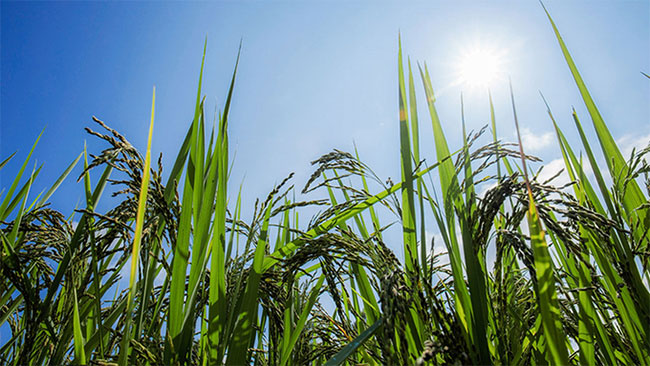China genetically engineered rice to increase productivity
The key D1 protein in photosynthesis of rice is genetically modified in the cytoplasm, helping to increase yield and heat tolerance.
Scientists from Shanghai Academy of Science and Technology, China, have researched and created a key unit in photosynthesis of rice by genetic process in cytoplasm . The genetic modification of the unit in rice helps the plant have good heat resistance and improve productivity.

Genetically modified rice. (Photo: Sciencemag).
During the study, the team found that when sunlight shines on rice, a protein complex called Photosystem II (PSII) stimulates electrons, promoting photosynthesis. However, high temperatures can affect the photosynthesis process of rice, disrupting the structure of a key protein unit, called the D1 protein. PSII only works to produce photosynthetic reactions when a new D1 protein unit is inserted. If the production rate of D1 protein is increased further, photosynthesis will take place smoothly.
Instead of making D1 protein from chlorophyll synthesis, the team created D1 by genetically modifying the cytoplasm with a durable, heat-resistant structure.
Experiment with a sample of the Arabidopsis thaliana crucifer, a group that extracts the chlorophyll gene of D1, combines with a piece of DNA that is activated under heat pressure and inserted into the nucleus of the cell. Results showed that Arabidopsis thaliana can tolerate temperatures as high as 41 degrees Celsius for 8.5 hours, while this plant normally experiences high temperatures that have stopped photosynthesis and wilt.
"This case is applicable to rice. If under normal temperature, the rice yield when genetically engineered increases by 20% compared to normal photosynthesis rice," said Fang Qing Guo, the institute. Physiology and Ecology Plant said.
Sunlight is a major factor in photosynthesis, and rice plants convert sunlight into sugars for growth. The higher the sun's temperature, the easier it is for the photosynthesis to go out of control, and some chemical reactions will accelerate or slow down, affecting the plant's growth. Therefore, this study is a breakthrough in increasing photosynthetic efficiency and crop yield under normal and high temperature conditions.
- The most common GM foods
- Scientists have found a way to use genetically modified rice to prevent HIV
- China successfully bred purple rice for cancer treatment
- Genetically modified rice is rampant in China
- The creator of the transgenic baby in China is sentenced to 3 years in prison
- Successfully growing high quality rice varieties from Japan
- China produces rice varieties higher than human heads for high productivity
- Rice productivity will increase by 30-50% in the next 10-15 years thanks to new varieties
- Bangladesh is about to become the first country to allow the cultivation of genetically modified golden rice
- New rice varieties improve productivity for Asia
- Discovering a new kind of rice gene for high yield
- China has successfully bred super hybrid rice
- Gene helps increase rice yield and quality
- Scientists warn about the reverse side of transgenic plants
 Why do potatoes have eyes?
Why do potatoes have eyes? 'Tragedy' the world's largest carnivorous life: Death becomes ... public toilet
'Tragedy' the world's largest carnivorous life: Death becomes ... public toilet Tomatoes were once considered 'poisonous' for 200 years
Tomatoes were once considered 'poisonous' for 200 years Detecting microscopic parasites on human face
Detecting microscopic parasites on human face